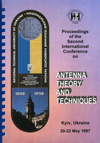The overview of the modern state of the electrical impedance tomography
DOI:
https://doi.org/10.1109/ICATT.1997.1235241Abstract
The purpose of electrical impedance tomography (EIT) is reconstruct an image of the electric conductivity distribution in transversal section of body by measuring voltages induced on the electrodes attached to the body surface while currents are passed between them. On this measurement data of currents and voltages the image of conductivity distribution inside bioobject is reconstructed [1, 2].References
Newell, J.C.; Isaakson, D.; Gisser, D.G. An electric current tomograf. IEEE Trans. Biomed. Eng., 1988, Vol. BME-35, p. 828-832.
Zhu, O.; Lionheart, W.R.B.; Lidgey, F.J.; McLeod, C.N.; Paulson, K.S.; Pidcock, M.K. An adaptive current tomograpf using voltage sources. IEEE Trans. Biomed. Eng., 1993, Vol. BME-40, p. 163-168.
Cheney, M.; Isaacson, D. Distinguishability in impedance imaging. IEEE Trans. Biomed. Eng., 1990, Vol. BME-39, p. 60-64.
Uebb, S. Physics of Image Visualization in Medicine. Moscow: Mir, 1991.
Cheng, K.S.; Isaacson, D.; Newell, J.C.; Gisser, D.G. Electrode models for electric current computed tomography. IEEE Trans. Biomed. Eng., 1989, Vol. BME-36, p. 918-923.
Hua, P.; Woo, E.; Webster, J.; Tompkins, W. Using compound electrodes in electrical impedance tomography. IEEE Trans. Biomed. Eng., 1993, Vol. BME-40, p. 29-34.

